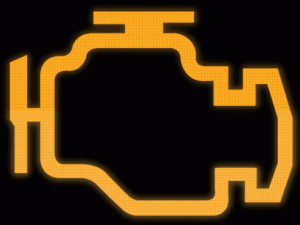Nissan Note Engine Warning Light
The Nissan Note engine warning light, also know as the malfunction indicator lamp (MIL), or check engine light comes on with the ignition being set to ‘on’ and goes off shortly after engine startup. This is normal and is part of a self-test. If the engine warning light comes on after the engine has started, a fault has been detected. In this instance, the warning light either comes on steady or it flashes.
Nissan Note Engine Warning Light
Certain versions of the Nissan Note have a orange engine warning light and a red engine warning light. These engine warning lights are generic fault lights and there are many possible faults that are related to it.
The only method to understand what the fault is, is to use a diagnostic fault code reader. These can easily be purchased online and are now very affordable, failing that, most vehicle workshops will do this. Most common engine warning fault lights are due to:

- Blocked fuel injector
- Loose fuel cap
- Spark plug/s
- Coil pack
- Mass air flow sensor (MAF)
- Lambda fault
- O2 sensor
- Oil deterioration
- Water in the fuel filter (engine warning light also illuminates – diesel models only)
- Vehicle runs out of fuel
Prolonged driving with the engine warning light on may increase fuel consumption, higher harmful exhaust emission and potentially cause damage depending on the fault. In certain cases, damage may not be covered by vehicle warranty (if applicable).
Flashing Engine Warning Light
If your Nissan Note engine warning light is flashing, this can indicate an engine misfire. Symptoms may include erratic sounding engine, smoke from the exhaust and a loss of power. This can be potentially damaging, particularly to the catalytic converter where unburnt fuel may ignite and cause damage. To reduce or avoid damage:
- Avoid driving at speeds above 70 km/h (43 mph).
- Avoid hard acceleration or deceleration.
- Avoid steep uphill grades.
- If possible, reduce vehicle weight.
After taking remedial action, the engine warning light may stop flashing and illuminate steady. It’s advisable to have the vehicle checked as soon as possible.
What to do when the Engine Warning Light Comes on
If you’re confident to work on your own vehicle and the warranty has expired, you’ll need to purchase or borrow a diagnostic fault code reader. These code readers vary in terms of ability and information given, so a little research is required to find the best reader for your particular vehicle. They can now be purchased at very affordable prices from many online stores. The code reader will provide you with a fault code and either provide you with a specific fault or point you in the general area.
Alternatively, book your vehicle in with Nissan or any good independent vehicle repair workshop.
Reduced Engine Power
As a safety precaution, your Nissan Note may operate with reduced engine power – also known as limp mode. This is a normal procedure on most vehicles that’s designed to reduce potential damage to the vehicle when an engine malfunction has been detected.
Reset Engine Warning Light
On certain models of Nissan Note you are able to reset the engine warning light. To do this cycle the ignition to on and off six times. If the fault was temporary, then the reset procedure will turn off the warning light. If the fault is still present and ongoing, the warning light will remain on regardless.
| Nissan Note Warning Lights Guide |
|---|